Intervention and Evolution
At Emmanuel Church, West Hampstead, London
Neil McLaughlin
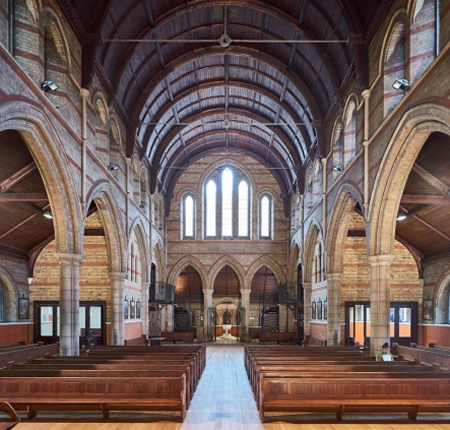 |
|
| The nave and narthex of Emmanuel Church, West Hampstead, with completed community rooms to either aisle and simple railings (Photo: Thomas Erskine) |
Like most historic buildings, churches develop over time to accommodate the changing needs of the people who use them. For churches today, this means adapting as congregations and surrounding communities fluctuate, and in order to remain at the centre of local activity, many historic churches find they need to diversify.
By providing multifunctional meeting rooms and modern kitchen and toilet facilities, churches can cater for a wide range of local groups. Together with improved heating, lighting and level access, these interventions vastly improve the flexibility of service which churches can offer their communities. However, these changes can be difficult to achieve in a historic building, especially one that’s listed.
Located in West Hampstead and close to inner-city areas of great depravation, the church of Emmanuel illustrates well how even listed places of worship can respond to the challenge of diversification. Today, this Edwardian parish church hosts activities organised through the West Hampstead Community Association and it has longstanding partnerships with Alcoholics Anonymous and Narcotics Anonymous. Emmanuel Church also participates in a winter night shelter scheme for the homeless, which is operated by 14 Camden churches from a variety of denominations. The churches take it in turns to accommodate up to 16 homeless adults a night, providing hot meals, showers and beds.
For the architects commissioned to adapt Emmanuel Church, Francis Maude and Neil McLaughlin from Donald Insall Associates (DIA), the first step was to assess its significance. Using this knowledge as the basis of proposed new interventions, DIA was able to balance careful conservation against sensitive new insertions in locations of lower historic impact.
Listed Grade II, this Edwardian Gothic Revival church was designed by the architect JA Thomas of Whitfield & Thomas in 1896 to replace a smaller church situated a few streets away. Built in red brick externally, with fair-faced white brick with red details and stone dressings internally, the chancel and four bays were consecrated in 1898. A pause in construction due to a lack of funds meant that the nave, narthex and porches were not completed until 1903, with only the ground and first floor of the tower eventually being built.
In 1968, a meeting room with a flat roof was installed in the south aisle and around the same time half of the pews were removed and a WC and a small kitchen area were installed in the south west entrance porch. By the end of the century, demand for community space had increased dramatically, and having the right spaces and facilities had become increasingly important to fulfilling Emmanuel’s vision of its role in the community.
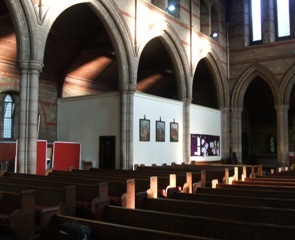 |
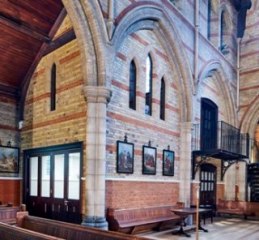 |
|||
| The former single storey meeting room to south aisle, built in 1968 (above left) and the new brick-walled community rooms which replaced it (above right) | ||||
In 2007, the Reverend Professor Peter Galloway, who was then the priest in charge, instructed the church’s architects to provide options for repairing the uneven main floor to make all areas of the church floor safe and accessible.
Responding to the increase in demand from local groups for spaces to hire, it was also suggested that extra community rooms within the nave and aisles might be added as the existing facilities could not keep up with demand. In line with the increase in meeting room space, the kitchen and toilet facilities required updating to include a new accessible toilet and level access from the entrance porches.
Proposals halted when Peter Galloway sadly passed away in 2008, but discussions started again with great fervour in late 2009, under instruction from the Reverend Jonathan Kester, the new priest in charge.
STRUCTURAL ISSUES
One of the main items noted by DIA in earlier quinquennial inspection reports was the structural movement of the floor in the main body of the church. By the time the project restarted, parts of the parquet floor had become so buckled that level changes of around 100mm were evident in various parts of the church, causing trip hazards and limiting their use.
Although Emmanuel Church has been kept in reasonable condition since it was constructed, it has a history of structural movement. Underpinning and structural restraint ties were required at the east end of the church following dry summers in the 1920s and bombing during the second world war had caused cracks to the north aisle which were repaired in 1953. The church had also experienced movement in the north nave arcade in the west end of the church following a dry summer in the mid-1990s.
Given the history of structural movement caused by the soft clay on which the church is built, Stuart Tappin of Stand Consulting Engineers arranged soil investigations in early 2010 and provided structural advice for proposals to rectify the uneven floor. The conclusion was that the best solution was to remove the existing floor slab completely throughout the nave, aisles and narthex, and to replace it with a new slab supported on 30 piles over a void, as this would allow for future clay movement. In addition, a screed incorporating underfloor heating was proposed which would allow the removal of the wall-mounted perimeter heaters and provide a more even level of heating.
DESIGN CHALLENGES
The removal of the existing floor slab meant the existing community room, which was of a low historic significance, would need to be dismantled. It was decided to use the footprint of this room as a basis for the new proposals. Installing a further community room of the same footprint in the opposite north aisle would not only double the existing footprint for spaces to hire, it would also restore balance to the nave. The remainder of the aisles were to be left available for parking prams and buggies, a requirement during services and for many of the community room user-groups.
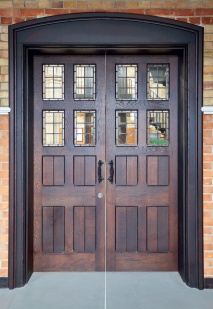 |
|
| One of the new community room doors with traditional leadwork and bespoke ironmongery (Photo: Thomas Erskine) |
From an enhanced brief on the requirements of church users, it was clear that the list of existing patrons was already extensive. Many other potential users were also interested in hiring space but required improved facilities – further evidence that the maximum number of new community rooms was necessary.
It was decided to install the new kitchen and accessible toilet within the ground floor of the south aisle, leaving a smaller community room adjacent to it. The larger kitchen was, among other aspects of the proposed interventions, crucial for the future of the church, not only for providing coffee and tea following services, but as somewhere groups hiring the community rooms could prepare their own refreshments, as a facility for larger events such as concerts, and to prepare hot meals as part of the homeless shelter scheme.
Likewise, the accessible toilet was not only essential for those in the parish with special mobility requirements, this room was to provide a baby changing station for parents and a shower for use by homeless people.
The architects also prepared a proposal for new railings with central gates to the narthex arched openings, in keeping with the aesthetic of the church, but of sufficient height to prevent climbing. These were needed to provide secure separate access to the main body of the church when the community rooms are in use.
Access improvements also included proposals for a new internal ramp to the north-east porch, paved with tiles to match the originals. This would replace a steep and rather ugly concrete ramp which had been built inside the porch, rather than building it externally where it would detract from the quality of the architecture and its setting – a conservation area.
In 2010, the architects prepared proposals that were sent to the Diocese of London for their initial feedback. Because the funds available for the project were then unknown, the proposals included two options, one with community rooms on the ground floor only and a second option including upper community rooms with associated metal staircases to access them. The architects met with representatives from the London Diocesan Fund on site to review the proposed designs and some amendments were made to the design of the new railings to the narthex to reflect other modern railings at the other end of the nave.
In late 2010 certification was received from the diocesan advisory committee (DAC) recommending the proposals, and a quantity surveyor was then engaged to prepare preliminary cost estimates for the different options.
As a place of worship owned by one of the exempt denominations, alterations which would usually require listed building consent are dealt with under the ecclesiastical exemption, so there was no requirement for listed building consent. However, the DAC’s recommendation included the requirement to consult with the local planning authority and the Victorian Society because of the extent of the proposals and the impact they would have on the Grade II listed building.
Consultations with Camden Council conservation officers and the Victorian Society progressed through 2011 and in December the designs were presented to the DAC’s plans group of consultant architects and surveyors for comments. In addition to requiring further information from the structural engineer, the group suggested increasing the kitchen and toilet facilities, but as this could not be achieved without losing one of the two ground floor community rooms, the proposals remain unchanged.
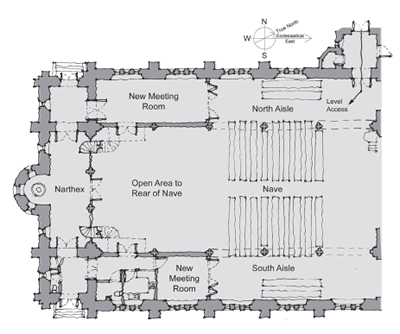 |
||
| Plan showing the new meeting rooms and their separated access route via the narthex |
Following changes in local authority planning policy, charges were introduced by Camden Council for all consultations, and the DAC agreed that further advice from council officers was no longer required. However, the Victorian Society continued to advise and was supportive of the plans.
No objections were raised to the structural proposals for the floor or to the new narthex railings, but the society was concerned that the full-height infills within the aisle arches to form the new community rooms could cause visual harm. Further discussions addressed the position of the walls in relation to the arch columns and the form of construction the new insertions should take.
Following the preliminary cost estimates prepared by the quantity surveyor, it was decided to tender the project in November 2013 as the church needed to be absolutely sure that adequate funding was in place before appointing a main contractor. From the tenders received it was apparent that extra fundraising would be required.
Furthermore, costs increased when, in another part of the church, the roofs above the north and south aisles together with their cast iron gutters and downpipes also began to need attention. The favoured main contractor undertook these repair works in 2014 following receipt of a separate faculty from the London DAC, in advance of the major internal project. Unfortunately, this main contractor went into administration in early summer 2015, so a new tender issue was planned.
In line with the established conservation principles, it was decided that the new community rooms should be constructed in brickwork to match the surrounding walls, rather than in painted plasterboard like the 1968 meeting room walls. Although a lightweight timber frame and plasterboard may seem the more reversible of the two options, steel beams would have been needed to support the upper community room floor structure. By progressing the design further with structural input from Stand Consulting Engineers, it was agreed that the proposed brick masonry infills would be a more ‘honest’ intervention, and would form a more permanent part of the building’s story as a place which evolves to meet the needs of the parish.
After presenting this approach to the Victorian Society, outlining how the masonry designs would effectively be as reversible as a timber frame design, the society confirmed in mid-summer 2015 that it would not object to the granting of a faculty. The senior conservation adviser (churches) at the Victorian Society expressed the view that:
By being designed with permanence in mind, the proposed subdivisions will benefit from a quality of design and materials that will actually make them less harmful than similar subdivisions in studwork which might be just as ‘permanent’ in practice.
The proposals were duly granted a faculty by the Diocese of London in July 2015 and a tender for the works was issued to main contractors the following month. By January 2016 the project had started on site, with the nearby Emmanuel Church of England School used for services as the works progressed.
COMPLETION
The project achieved practical completion in November 2016 and was dedicated and officially opened the same month. The completed works were so seamless with the existing building that during the opening ceremony many guests unfamiliar with the previous internal layout had to ask what the works had entailed.
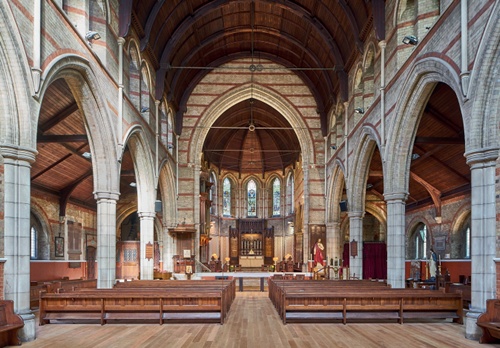 |
|
| The nave and chancel of Emmanuel Church, West Hampstead with its new oak floor (Photo: Thomas Erskine) |
From its earliest beginnings Emmanuel Church has been a place developing to reflect the ever-changing needs of its parish.
From the construction of a larger church for an increasing congregation in 1898, to the removal of pews and creation of the 1968 meeting room, to the new community spaces completed in 2016, the church has continuously responded to changing needs and circumstances.
Financing at Emmanuel Church, as with many large historic structures, has been a factor throughout the history of the building’s development, with elements being completed as and when resources were available.
Although this project took close to a decade from inception to completion, the resulting new community spaces and ancillary areas will suit a wide range of uses, where all the previous users of the church can be accommodated and many more can be welcomed. The project will provide income for future maintenance work and has allowed the church to remain a cultural centre for the West Hampstead community.



